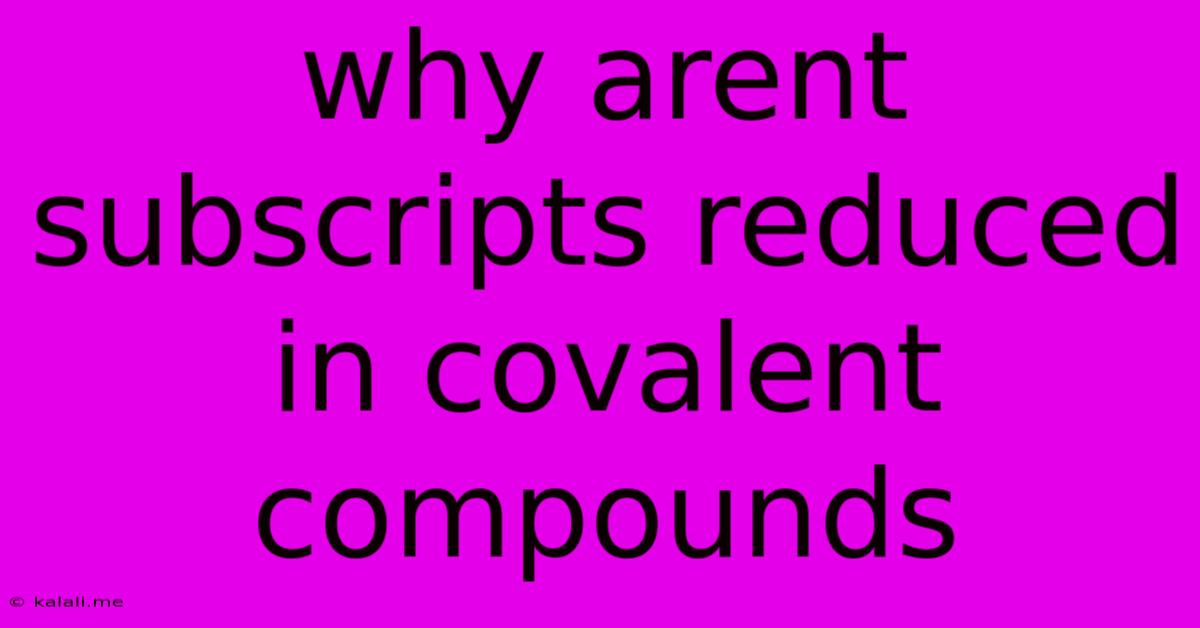Why Arent Subscripts Reduced In Covalent Compounds
Kalali
May 23, 2025 · 3 min read

Table of Contents
Why Aren't Subscripts Reduced in Covalent Compounds? A Deep Dive into Chemical Formulas
Chemical formulas are the shorthand language of chemistry, allowing us to represent the composition of substances concisely. While we routinely simplify ratios in many mathematical contexts, the subscripts in covalent compound formulas remain unreduced, even if they share a common factor. This seemingly simple rule hides a crucial concept about the actual structure and composition of molecules. Understanding why requires a closer look at what those subscripts actually represent.
This article will delve into the reasons behind this key difference between representing ionic and covalent compounds, exploring the molecular structure, and the crucial role subscripts play in conveying essential information about the molecule. We'll also address common misconceptions and offer clear examples to solidify your understanding.
The Significance of Subscripts in Chemical Formulas
In chemical formulas, subscripts indicate the number of atoms of each element present in a single molecule. This is fundamentally different from the way ratios are presented in simpler mathematical expressions. For instance, in the formula H₂O (water), the subscript '2' explicitly states there are two hydrogen atoms bonded to one oxygen atom in each water molecule. This ratio of 2:1 is an intrinsic part of the molecule's structure and identity.
Reducing the subscript in H₂O to HO would fundamentally alter the meaning. HO represents a completely different chemical species, a hydroxyl radical, which has entirely different properties. This illustrates the crucial point: subscripts aren't just ratios; they represent the actual atomic composition of a single molecule.
The Contrast with Ionic Compounds
The difference becomes clearer when comparing covalent and ionic compounds. In ionic compounds, like NaCl (sodium chloride), the subscripts represent the ratio of ions in the crystal lattice. We write NaCl, not Na₂Cl₂ or Na₃Cl₃, because the simplest whole-number ratio accurately reflects the ionic arrangement. The formula doesn't represent a single NaCl molecule; rather, it describes the ratio within the extended crystal structure. Reducing the subscripts in ionic compounds simply provides the simplest form of that ratio.
However, covalent compounds exist as discrete molecules with a specific number and arrangement of atoms. The subscripts directly reflect this molecular structure. Changing the subscripts changes the molecule.
Why We Don't Simplify Covalent Compound Formulas: Key Takeaways
- Molecular Structure: Subscripts in covalent compounds represent the precise number of each type of atom in a single molecule, defining its unique properties and behavior.
- Distinct Chemical Species: Reducing subscripts would create a different chemical species with different physical and chemical properties.
- Empirical vs. Molecular Formulas: While empirical formulas show the simplest whole-number ratio of atoms, molecular formulas (the ones we typically use for covalent compounds) display the actual number of atoms in a molecule.
- Accuracy and Precision: Maintaining the unreduced subscripts ensures accuracy in representing the composition and structure of covalent molecules.
Examples Illustrating the Importance of Unreduced Subscripts
Let's consider a few examples:
- H₂O₂ (Hydrogen Peroxide): Reducing this to HO would yield a completely different compound, a hydroxyl radical.
- C₂H₆ (Ethane): Reducing this to CH₃ would result in a methyl radical.
- C₆H₁₂O₆ (Glucose): Reducing this would significantly alter the chemical formula and the resulting molecule would be entirely different.
In conclusion, subscripts in covalent compounds are not reduced because they represent the precise number of atoms in a single molecule, defining its unique identity and properties. Unlike ionic compounds where the subscripts denote the simplest ratio within a lattice, covalent compounds exist as distinct molecular entities. Maintaining unreduced subscripts is essential for accuracy and clarity in chemical notation. Understanding this distinction is crucial for a thorough grasp of chemical formulas and molecular structure.
Latest Posts
Latest Posts
-
How To Add Oil To Ac Compressor Without Vacuum
May 23, 2025
-
Tranport To Random Location Spell 5 E
May 23, 2025
-
How To Paint A Rusty Car Roof
May 23, 2025
-
What Do The Kids In Willy Wonka Represent
May 23, 2025
-
Iterm Open New Tab In Same Directory
May 23, 2025
Related Post
Thank you for visiting our website which covers about Why Arent Subscripts Reduced In Covalent Compounds . We hope the information provided has been useful to you. Feel free to contact us if you have any questions or need further assistance. See you next time and don't miss to bookmark.